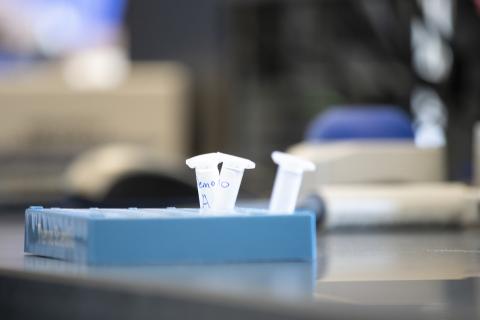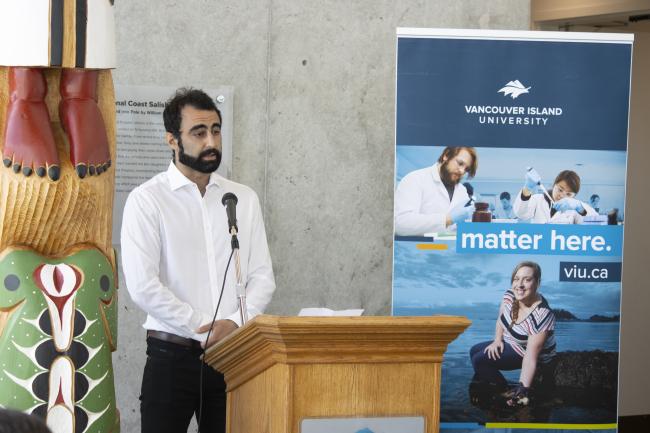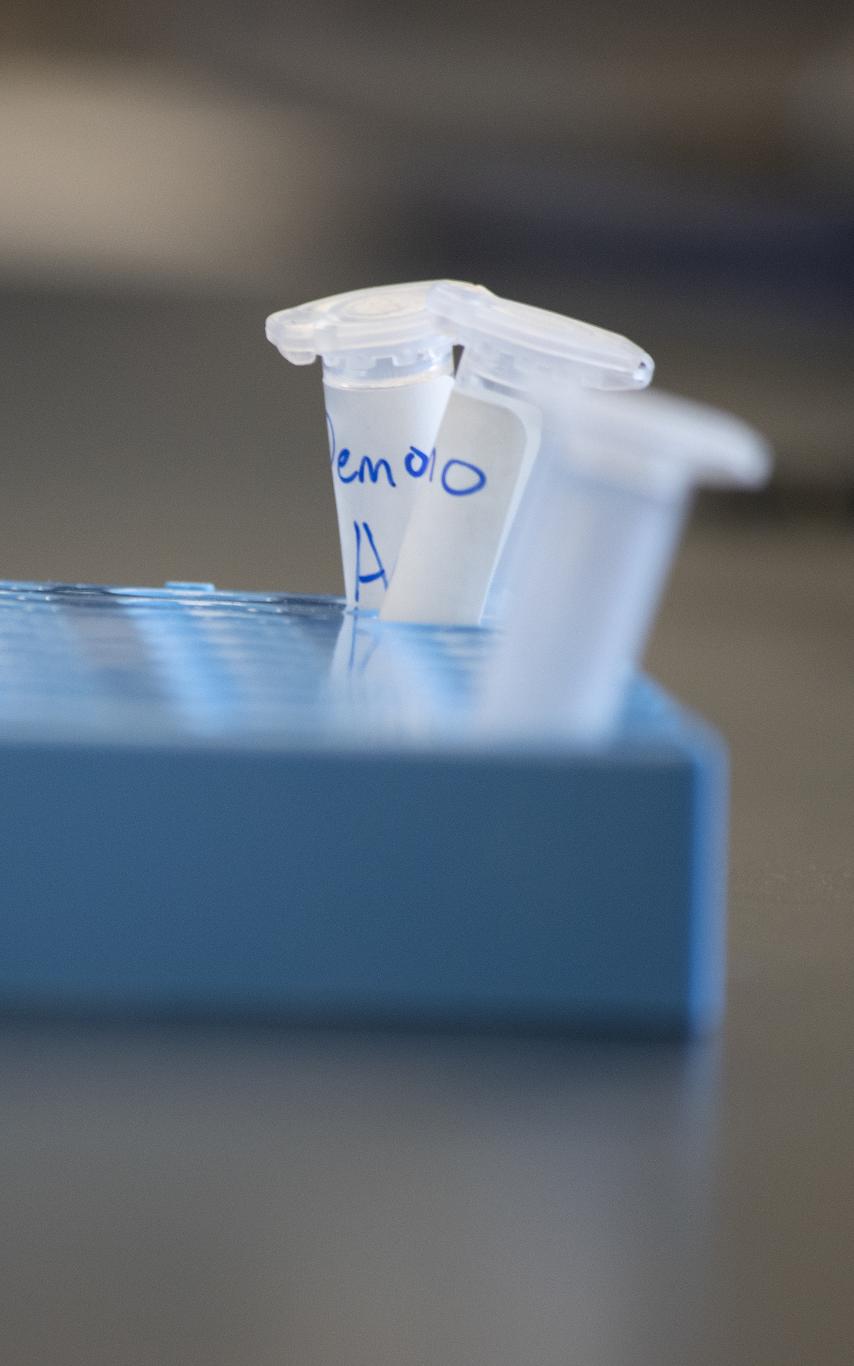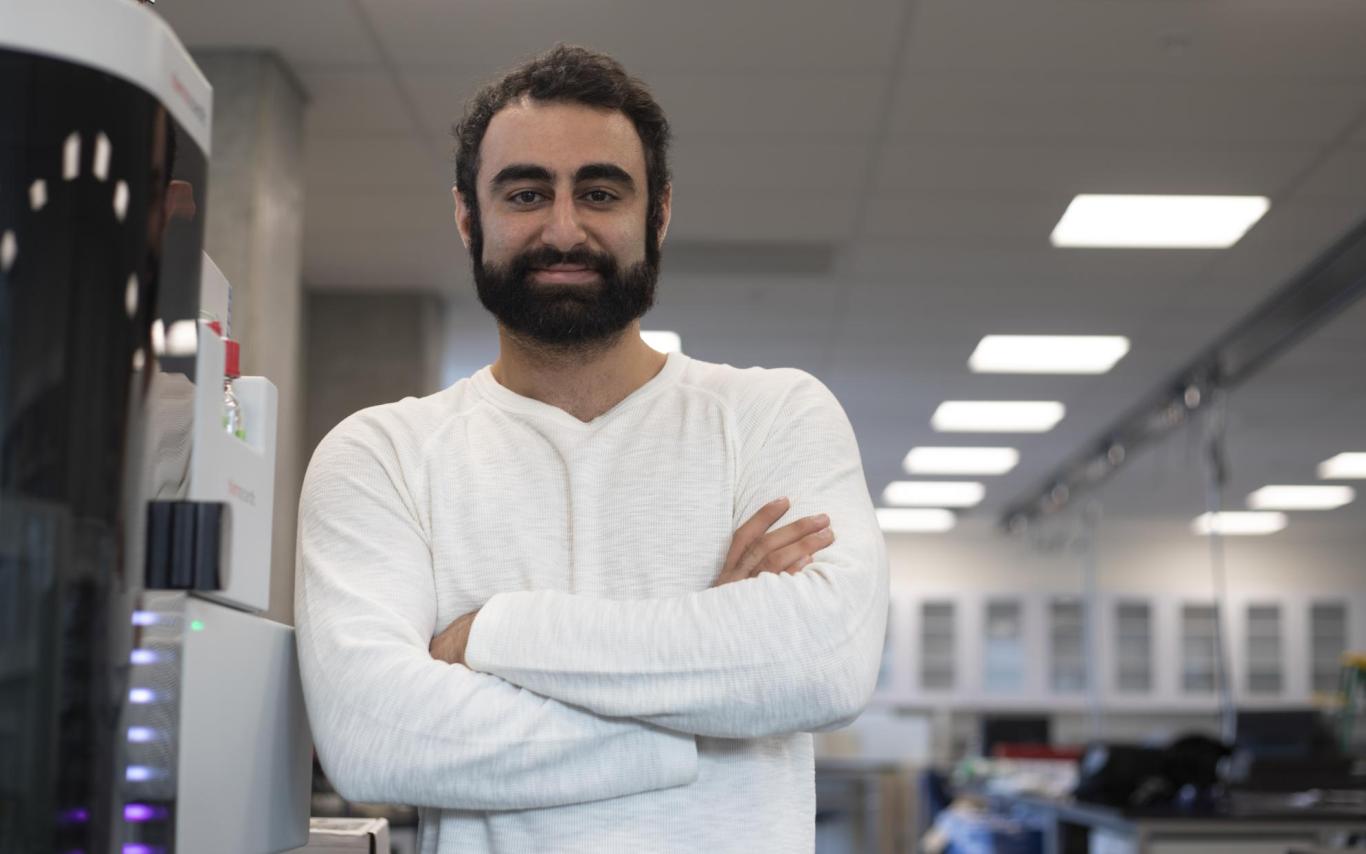One alum’s story of personal healing and joining the fight against the opioid epidemic
Editor’s note: This feature article is being published posthumously with the permission of Armin Saatchi’s family. Armin passed away in October 2022, prior to defending his Master of Science in Chemistry. To honour his memory, the family is establishing a memorial award in his name at Vancouver Island University. To contribute, please connect with the VIU Foundation.
VIU alumnus Armin Saatchi has a strong vision of where he wants his life to go.
He received a Natural Sciences and Engineering Undergraduate Student Research Award, worked as a research assistant for the University’s Applied Environmental Research Laboratories (AERL) and graduated with a major in biology. He is completing a Master of Science degree at the University of Victoria, is continuing to do research at the AERL, and plans to go to medical school to become a pediatrician.
But it’s been a hard road to get where he is now.
“I don’t remember a lot of my life between the ages of 15 and 23. It’s just pieces,” says Saatchi. “A lot of the days were kind of the same. It was like Groundhog Day. I lived the same day over and over again. My life, like the recovery literature says, had become centered around getting and using drugs. It’s a sad way to live. It’s a very small life. How do you dig yourself out of that? I didn’t. I got yanked out.”
The path to recovery
Saatchi started getting drunk and high as an adolescent as a means of social acceptance and then later it became a necessity because of his addiction. After high school he enrolled in college because he felt that was what was expected of him.
“My post-secondary courses before I got sober were a farce. I used enrollment to keep my family happy and quiet. The parental expectation was there. I was expected to go to college. As long as I was enrolled there was more leeway, more bargaining power to protect my addiction,” says Saatchi.
An intervention changed the course of Saatchi’s life. One day he found himself in a room with friends and family staring at him, clutching pieces of paper in their hands.
“At that point I was done. I didn’t have any fight left to protect what had become my way of living,” says Saatchi. “I got sober on Remembrance Day, 2013. I had a lot of help, very good treatment and the support of my family. I had a lot of privileges in early recovery that many people don’t have.”
After his treatment, he lived in a sober house and then eventually on his own. Saatchi had to learn basic life skills like how to cook for himself and manage money. Then one day he found himself wondering what’s next in his life.
“I found myself in a year of change, wondering what my life would look like in five years, in 10 years,” recalls Saatchi. “I looked around at the other people in my life and they had things I wanted. They had a future they were looking forward to, they had opportunities and prospects. I started thinking about what I wanted in my life.”
He decided to go back to post-secondary and enrolled in VIU’s Adult Basic Education program to upgrade high school courses and prepare for university-level learning.
“It was easily the best educational decision I’ve ever made. Without that program, I would have bombed,” says Saatchi. “The teachers really take the time and make sure you’re set up for success. My teachers were Linda Neilson and Charlene Stewart and they really go the extra mile in that program. It’s amazing.”
After upgrading, he enrolled in VIU’s Bachelor of Science program. He passed his first-year courses and continued into second year. For Saatchi it was a momentous occasion. After trying and failing at college courses in his early 20s, he had finally made it past first year.
“I had been repeating first-year courses in an unfit state for years and when I finally got to second-year courses I felt like I made it,” explains Saatchi.
After second year his organic chemistry instructor, Dr. Jessie Key, offered Saatchi a research position for the summer. By that time Saatchi knew his goal was to attend medical school so he accepted the opportunity.
“That’s what started my pursuit of research,” recalls Saatchi. “Jessie fought tooth and nail to get some funding for three students to have summer projects doing organic synthesis. Those kinds of opportunities really set up a person for success.”
The research work gave the students the opportunity to learn in a professional setting.
Meeting community needs through harm reduction
In third year, one of his classmates dared him to take one of the harder chemistry classes as an elective. That’s where he met Drs. Chris Gill and Erik Krogh, VIU Chemistry Professors and Co-directors of the AERL. After he finished the course, they invited him to work for the lab during the summer.

That opportunity led him to become involved in VIU’s Harm Reduction Drug Checking Pilot Program, led by Gill. The team of researchers has developed a system that rapidly identifies and measures toxic substances, such as fentanyl, carfentanil or etizolam in drug samples. As part of the project, the team, in collaboration with Vancouver Coastal Health, took their technology to The Powell Street Getaway Safe Consumption Site, located in the Downtown Eastside neighbourhood (DTES) of Vancouver, BC.
As a person in recovery, working at the harm reduction site had a profound impact on Saatchi.
“It was sad to see how far people were willing to go to protect their disease and in that same breath how incredibly difficult it is for some people to get out of it … We have this perception of people who live down there [the DTES] that they must have always been like that. It’s hard to look at someone in a place like that and think that was somebody’s baby … and at some point, for a manifold number of reasons life kind of went to hell,” says Saatchi.
“And for myself I had every advantage in getting clean, every possible bit of help was made available to me. Those people, it’s sad to say, are in many cases very much on their own and living a very, very hard way of life, unimaginably difficult.
“Being in that environment made me very sad because there is no magic bullet. Drug testing isn’t going to do it alone, clean supply isn’t going to do it alone. Decriminalization, social programs, none of these things in isolation is going to do it alone. Seeing the magnitude of the problem and how complicated that situation is depressed the hell out of me. I felt super defeated as a man in recovery being there. But there are still people on the front lines fighting and advocating every single day to try and take down pieces of this issue.”
Saatchi will never forget the first sample he prepped during the project.
“My hands were shaking so hard, I had my professors behind me waiting for the first sample, and a few people from Thermo Fisher Scientific … so I had all these important eyes on me and I had dope in my hands for the first time in a long time. And I had an itty-bitty spatula and I was meant to weigh out a milligram.”

Helping others
Saatchi’s decision to apply to medical school was influenced by his recovery and by people who helped him during treatment.
“I was very fortunate to know a few individuals in early recovery who are the ‘make-time’ type of people. Those are very rare and exceptional individuals,” says Saatchi. “I’d like as much as I can to follow that example, in doing service work in the recovery community. It has been my experience that life is better when we make ourselves available to others.”
Saatchi says the medical field is a career that offers unlimited opportunity for growth and parallels the trajectory of recovery.
“You start off not knowing much, and as time goes on you grow and take on more and more responsibility. Early in recovery I needed help from others and then later in recovery I became that help for others. The two paths kind of walk side by side.”

A Harm Reduction Response to the Opioid Crisis
VIU’s Harm Reduction Drug Checking Pilot Program, led by Dr. Chris Gill, VIU Chemistry professor and Co-Director of the AERL, involves a team of researchers that developed a breakthrough paper spray mass spectrometry-based drug-testing system, which rapidly identifies and measures toxic substances, such as fentanyl, carfentanil and etizolam. The presence and varying levels of these and other dangerous drugs has been responsible for astonishing increases in the number of overdoses and deaths during the opioid overdose crisis, especially during COVID-19 response measures.
Thermo Fisher Scientific is an integral partner in the program, as the company has loaned VIU a state-of-the-art VeriSprayTM PaperSpray ion source mass spectrometry system to allow Gill and his colleagues to further refine their drug testing methods. For drug testing, a small sample is placed on a paper strip, which is inserted into a mass spectrometer for direct analysis. An important difference in their method over those currently in use is its ability to provide accurate concentrations for trace levels of multiple toxic drugs in minutes. The researchers continue to refine drug testing methods through collaborations with the Vancouver Island Drug Checking Project in Victoria.




